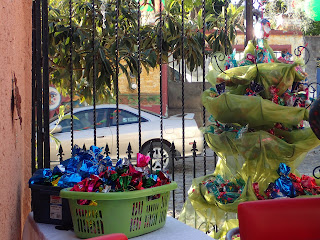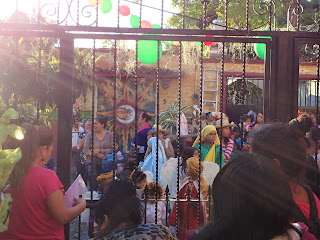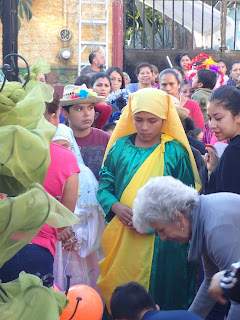 Another novena! This time for the 9 days leading up to Noche
Buena, aka Christmas Eve. Noche Buena is also what they call the poinsettia
here; the flower (which is actually a multi-flowered shrub) is native to
Mexico, and was brought to “poinsettia” fame by a U.S. Ambassador to Mexico in
1822 – named…Poinsett. Noche Buena is much easier to day, and much easier on
the ear.
Another novena! This time for the 9 days leading up to Noche
Buena, aka Christmas Eve. Noche Buena is also what they call the poinsettia
here; the flower (which is actually a multi-flowered shrub) is native to
Mexico, and was brought to “poinsettia” fame by a U.S. Ambassador to Mexico in
1822 – named…Poinsett. Noche Buena is much easier to day, and much easier on
the ear. |
| Decorations of balloons and moss |
The fiesta is called La Posada (The Inn) and is another re-enactment,
this time of Maria y Jose looking for a place to stay in Bethlehem. For 9
evenings, each night in a different neighborhood -- groups of kids, parents and
abuelas/abuelos march to a designated home. The people of the house sponsor the
evening’s events.
Maria rides on a burro, lead by Jose. They are preceded by a few
kids dressed as angels, and followed by a small vignette of the pair, with
burro, on poles on the shoulders of some of the older kids. And then they are followed
by the aforementioned children and families. The one we observed had at least
200 kids in the street.
As the procession reaches the sponsoring home / gate / door, the
puerta is closed, and the assembled crowd in the street begin to sing a
traditional song, first the kids outside, then a response by the people inside.
The gist of the song is simple – we are poor pilgrims from Nazareth, please let
us in / no, we have no room / but please, this is Mary, the mother of God. And
so on. It is a lovely little song, and has many verses, including one which
translates roughly as “go away, you may be a rascal and thief and I will have
to beat you.” Awesome.
Eventually the problem resolves when the innkeeper recognizes that
this is THAT Mary and Joseph, and welcomes them in (to the inn). Come in! And
have gifts! And candy!
 |
| A lot of gifts! |
The formalities taken care of, the kids crowd in for the real
incentive (we think) for this event – candy and piñatas. Each child gets a
small bag of candy and treats (one wonders if dentists sponsor all of these evenings!).
Then 3-4 piñatas come out, and one by one are demolished by the kids, while they
sing “Da le! Da le! Da le!” (rhymes with last name of Salvador), the
traditional piñata-bashing song. The ones we saw included an elf (take that,
Keebler!), Santa (ouch!) and an angel (really?). Mark speculated that a nun
with a ruler would be a more appropriate target for these kids than an angel,
but hey -- we’re new here.
These Posadas go on for 9 days, and on 24 de Diciembre, an actual baby joins as part of the creche in Ajijic, the zocalo. Here, and in some other areas of Mexico, is it thought the baby Jesus brings the gifts and they are opened on Christmas Eve. In areas closer to the U.S., it is Santa Claus and December 25. Oh, and wait, the whole Christmas thing isn’t over yet…Some say the 3 Kings bring gifts on January 6, and if you get the baby in the King Cake, you bring the tamales on Candlemas Day, February 2! That seems a fair trade.
All in all, another look at a different way to celebrate Christmas, here on the fun side of the ($18 billion) wall.
(Diciembre, 2017)






No comments:
Post a Comment